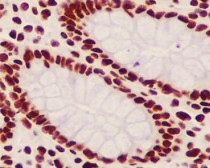ARG41372
anti-Histone H2B acetyl (Lys20) antibody
anti-Histone H2B acetyl (Lys20) antibody for ChIP,Flow cytometry,ICC/IF,IHC-Formalin-fixed paraffin-embedded sections,Immunoprecipitation,Western blot and Human,Mouse,Rat
Overview
| Product Description | Rabbit Polyclonal antibody recognizes Histone H2B acetyl (Lys20) |
|---|---|
| Tested Reactivity | Hu, Ms, Rat |
| Tested Application | ChIP, FACS, ICC/IF, IHC-P, IP, WB |
| Host | Rabbit |
| Clonality | Polyclonal |
| Isotype | IgG |
| Target Name | Histone H2B |
| Antigen Species | Human |
| Immunogen | Synthetic peptide around acetyl Lys20 of Human Histone H2B. |
| Conjugation | Un-conjugated |
| Alternate Names | Histone H2B.f; Histone H2B type 1-B; Histone H2B.1; H2B/f; H2BFF; H2B.1 |
Application Instructions
| Application Suggestion |
|
||||||||||||||
|---|---|---|---|---|---|---|---|---|---|---|---|---|---|---|---|
| Application Note | * The dilutions indicate recommended starting dilutions and the optimal dilutions or concentrations should be determined by the scientist. | ||||||||||||||
| Observed Size | ~ 14 kDa |
Properties
| Form | Liquid |
|---|---|
| Purification | Affinity purified. |
| Buffer | PBS (pH 7.4), 150 mM NaCl, 0.02% Sodium azide and 50% Glycerol. |
| Preservative | 0.02% Sodium azide |
| Stabilizer | 50% Glycerol |
| Storage Instruction | For continuous use, store undiluted antibody at 2-8°C for up to a week. For long-term storage, aliquot and store at -20°C. Storage in frost free freezers is not recommended. Avoid repeated freeze/thaw cycles. Suggest spin the vial prior to opening. The antibody solution should be gently mixed before use. |
| Note | For laboratory research only, not for drug, diagnostic or other use. |
Bioinformation
| Database Links |
GeneID: 319178 Mouse HIST1H2BB |
|---|---|
| Gene Symbol | HIST1H2BB |
| Gene Full Name | histone cluster 1, H2bb |
| Background | Histones are basic nuclear proteins that are responsible for the nucleosome structure of the chromosomal fiber in eukaryotes. Nucleosomes consist of approximately 146 bp of DNA wrapped around a histone octamer composed of pairs of each of the four core histones (H2A, H2B, H3, and H4). The chromatin fiber is further compacted through the interaction of a linker histone, H1, with the DNA between the nucleosomes to form higher order chromatin structures. This gene is intronless and encodes a replication-dependent histone that is a member of the histone H2B family. Transcripts from this gene lack polyA tails; instead, they contain a palindromic termination element. This gene is found in the large histone gene cluster on chromosome 6p22-p21.3. [provided by RefSeq, Aug 2015] |
| Function | Core component of nucleosome. Nucleosomes wrap and compact DNA into chromatin, limiting DNA accessibility to the cellular machineries which require DNA as a template. Histones thereby play a central role in transcription regulation, DNA repair, DNA replication and chromosomal stability. DNA accessibility is regulated via a complex set of post-translational modifications of histones, also called histone code, and nucleosome remodeling. [UniProt] |
| Cellular Localization | Nucleus. Chromosome. [UniProt] |
| Calculated MW | 14 kDa |
| PTM | Monoubiquitination at Lys-35 (H2BK34Ub) by the MSL1/MSL2 dimer is required for histone H3 'Lys-4' (H3K4me) and 'Lys-79' (H3K79me) methylation and transcription activation at specific gene loci, such as HOXA9 and MEIS1 loci. Similarly, monoubiquitination at Lys-121 (H2BK120Ub) by the RNF20/40 complex gives a specific tag for epigenetic transcriptional activation and is also prerequisite for histone H3 'Lys-4' and 'Lys-79' methylation. It also functions cooperatively with the FACT dimer to stimulate elongation by RNA polymerase II. H2BK120Ub also acts as a regulator of mRNA splicing: deubiquitination by USP49 is required for efficient cotranscriptional splicing of a large set of exons. Phosphorylation at Ser-37 (H2BS36ph) by AMPK in response to stress promotes transcription (By similarity). Phosphorylated on Ser-15 (H2BS14ph) by STK4/MST1 during apoptosis; which facilitates apoptotic chromatin condensation. Also phosphorylated on Ser-15 in response to DNA double strand breaks (DSBs), and in correlation with somatic hypermutation and immunoglobulin class-switch recombination. GlcNAcylation at Ser-113 promotes monoubiquitination of Lys-121. It fluctuates in response to extracellular glucose, and associates with transcribed genes (By similarity). Crotonylation (Kcr) is specifically present in male germ cells and marks testis-specific genes in post-meiotic cells, including X-linked genes that escape sex chromosome inactivation in haploid cells. Crotonylation marks active promoters and enhancers and confers resistance to transcriptional repressors. It is also associated with post-meiotically activated genes on autosomes. [UniProt] |
Images (2) Click the Picture to Zoom In
-
ARG41372 anti-Histone H2B acetyl (Lys20) antibody IHC-P image
Immunohistochemistry: Paraffin-embedded Human colon tissue stained with ARG41372 anti-Histone H2B acetyl (Lys20) antibody.
-
ARG41372 anti-Histone H2B acetyl (Lys20) antibody WB image
Western blot: HeLa cells treated with TSA. Cell lysates were stained with ARG41372 anti-Histone H2B acetyl (Lys20) antibody.







